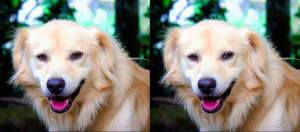WHAT ATTRACTS YOU TO YOUR DOG?
Julie Hecht is the lab manager of the Horowitz Dog Cognition Lab at Barnard College and the author of Dog Spies, a blog in Scientific American. She is a doctoral student in animal behavior and comparative psychology who has been working with Dr. Alexandra Horowitz since 2010 on the study of dog behavior and cognition.
I spoke with Hecht about their study “Seeing Dogs:Human Preferences for Dog Physical Attributes,” published in the March 2015 issue of Anthrozoös. Hecht, who is interested in dog welfare, said she and Dr. Horowitz wanted to better understand what attracts people to dogs.
Q. WHAT LED YOU TO DO THIS STUDY?
We were interested in the question of how and why people anthropomorphize dogs. We anthropomorphize everything—we see the human expression all over the place. With dogs, we make incredibly grand and in some cases aggravated attributions. You read such things in the American Kennel Club descriptions of dogs. (ed. Note: AKC describes a Pekingese, for example, as “regal in manner” and a Cocker Spaniel as “soft and appealing.”) You might [also] see a dog described as “large-eyed” and other attributes attached to the way a dog looks, instead of talking about how a dog behaves. But if a dog looks regal, that’s not telling you anything.
We wanted to test whether there are particular physical attributes that people are attracted to when they look at dog’s faces. So this is probably more a human study—except that the way humans make attributions to dogs can affect the human-dog relationship.
Q. HOW DID THE STUDY WORK?
We took 80 image pairs of adult dogs—and they were all mixed-breed dogs—and we considered 14 different physical attributions, so described in the study. There were baby-like, or paedomorphic, features: Things like bigger eyes, a larger cranium, a wider forehead, space between the eyes. We also considered some more humanlike attributes, such as a smile, colored irises, or an upturn of mouth. Some other considerations were symmetry and the presence of piebald coloration.
Then we modified each image within a very small change so the two images looked nearly the same, but were slightly different. Each image pair presentation explored only one modified attribute. And we asked our subjects to choose which of the two images they preferred.
Q. WHAT WAS THE OUTCOME?
Ultimately, we found that certain infantile features—not all, though—were attractive to people, as were certain human features. The subjects tended to like dogs that had slightly larger eyes, wider-set eyes, colored irises, and the upturned smile, even though such a smile might not mean the same thing behaviorally as it appears. Dogs do smile. For example, when a dog is “smiling” or pulling back its commissure, a person might say that dog is a happy dog. But if its ears are also back but it is “smiling” it is a scared dog. Or if the ears are pressing forward, these are behavioral characteristics of an angry dog.
People did not prefer dog images with an enlarged (infantile) head.
Q. WHY DOES IT MATTER HOW PEOPLE PERCEIVE A DOG’S APPEARANCE?
As I said earlier, the way a dog looks can affect the human-dog relationship. Our report states it so: “Our research could have implications for dog welfare. A recent ASPCA study found that people often adopt cats based on their behavior while dogs are often selected based on their appearance.”
“Animal rescue organizations can be cognizant of this phenomenon when presenting images of adoptable dogs. In line with the current study, animal rescue groups might consider incorporating preferred, salient features into their adoptable dog pictures—a picture of a dog with colored irises and a distinct ‘smile’ could be viewed preferentially. Further research could show whether aesthetic preferences might motivate potential adopters to meet a dog.”
Q. I ASSUME YOU HAVE OWNED DOGS. WHY HAVE YOU DECIDED TO STUDY THEM AS WELL?
Yes, I’ve been a dog owner. I got involved in ethology, the study of animal behavior, because I think I just didn’t like the idea of taking what is known about animals at face value. And I got interested in thinking about animal welfare, now a guiding theme in all of my work.
In some ways, even this study can relate to animal welfare, because in some cases we are breeding dogs with exaggerated features because people are attracted those features. But the morphology of features we are breeding—because people are buying it—are not always best for the health and well being of the dogs.
To try to put dogs on the same page with humans is an incorrect assumption. They live in a different cognitive, social, and sensory world. And yet dogs are incredibly attentive to the people that matter to them. As a species, they really do integrate much better than other species—cows, pigs, chickens—on our terms.
Interviewing Julie opened my eyes to the need for more human-dog research. The Horowitz Dog Cognition Labs have their own web page where you can follow their past, present, and future projects and where you can even sign up to have your dog involved in ongoing studies. Thanks, Julie.
Interviewing Julie opened my eyes to the need for more human-dog research. The Horowitz Dog Cognition Labs have their own web page where you can follow their past, present, and future projects and where you can even sign up to have your dog involved in ongoing studies. Thanks, Julie.

This was an incredibly interesting interview!
Thanks, yep I really wanted to visit the lab in person (I live not that far from Barnard College) but she was out of town. But I hope to volunteer my daughter's dogs for a study.